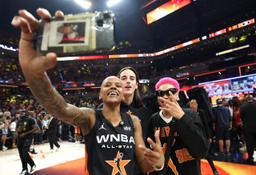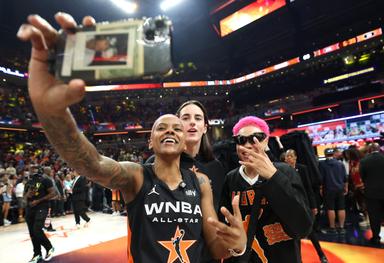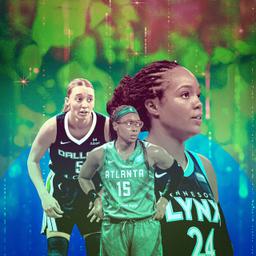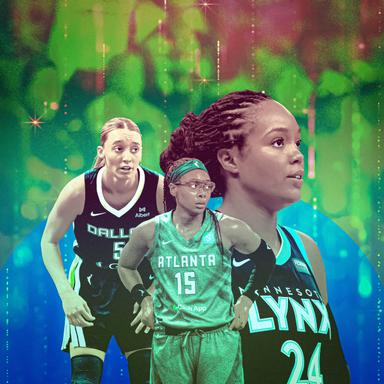WNBA All-Star Weekend Captured a League at an Inflection Point
The W is more popular—and profitable—than ever, but the league’s massive growth hasn’t translated to player salaries. Is the WNBA headed for a lockout? We go inside the ongoing CBA negotiations, the W’s unique ownership structure, and more.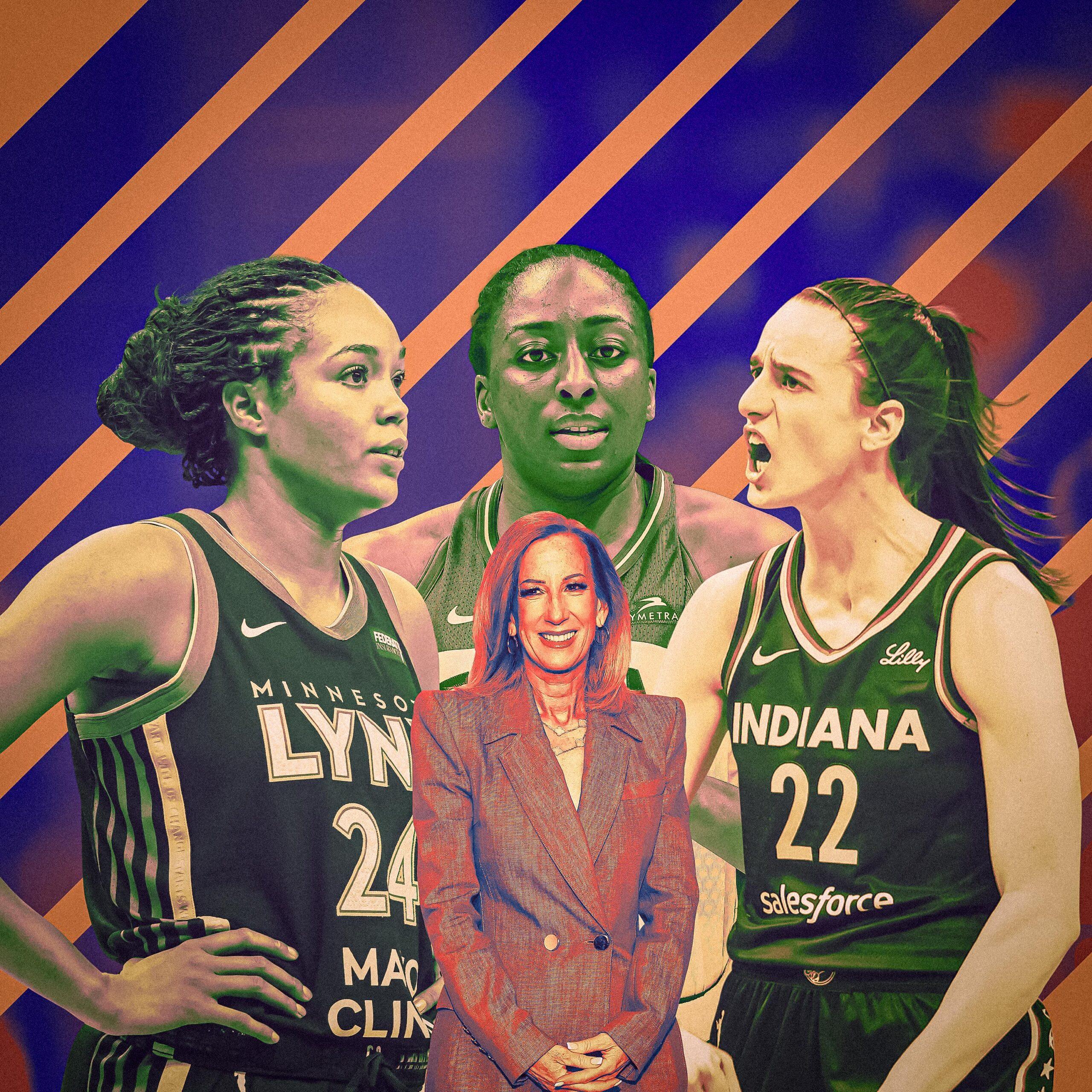
As WNBA All-Star Weekend in Indianapolis came to a close on Saturday night, the crowd at the Gainbridge Fieldhouse broke into what sounded like a predictable two-syllable refrain.
A colleague next to me on press row looked puzzled: “Are those … Cait-lin chants?”
We were startled by the fact that we were even startled—and then had a second surprise when we realized we were mistaken.
But so much had changed over the course of the weekend, which had opened with an uneasy mixture of foreboding and curiosity.
On Thursday afternoon, the Fever had announced via social media that Caitlin Clark would be missing the on-court festivities because of an ongoing groin injury. One could only guess how her injury would affect not only All-Star Weekend but also the CBA negotiations going on behind the scenes. A 30-story mural of Clark, the largest to ever adorn the city’s JW Marriott—despite the recent Swiftication of the city—felt like both a welcome sign and an existential threat.
The internet, meanwhile, crawled with conspiracy theories about jealous players and corrupt refs hurting Clark on purpose—speculation designed to deepen the perceived chasm between Clark and her peers.
But the Clark-sized hole in the proceedings became an opening for the StudBudz 72-hour livestream—an unsanitized lens into the adventures and mishaps of the pink-haired Minnesota Lynx duo of Courtney Williams and Natisha Hiedeman—to present the league with three-dimensional fun and shine an authentic light on a demographic the league has historically ignored. Clark herself watched the stream for three straight hours before making an appearance on it, one of the many moments this weekend that featured discourse-altering instances of Clark laughing, drinking, and standing in solidarity with her peers.
Two StudBudz, a Twitch stream, and a tripod did more to resolve a long-standing PR issue than anything the league has ever come up with. WNBA All-Star Weekend logged off Twitter and onto Twitch, and healing seemed to follow.
The growing audience for All-Star Weekend (beyond just Twitch) reflected the W's increased viewership across the season as a whole. Friday’s Skills Challenge and 3-Point Challenge drew 1.3 million viewers—almost doubling last season’s audience. Saturday’s ratings were down 36 percent compared with last year, when Clark played, but the 2.2 million people who tuned in were still a 158 percent improvement over 2023, mimicking a season-long trend: Clark is a generational draw, but she's not the league's only source of sustainable growth.
For the WNBPA, the league's players union, the weekend ended up being a gift disguised as a disaster. Yes, if Clark had participated in the 3-Point Challenge and fired 4-pointers from the AT&T logo, All-Star Weekend could have racked up as many views as the Coldplay couple. But the W showed that it could still put on a show without Clark participating, while also embracing the attention that she's brought to the league.
And the chants? To drown out WNBA commissioner Cathy Engelbert’s speech, fans echoed the players’ weekend-long demand: “Pay them! Pay them! Pay them!” (And not Cait-lin, like I'd initially thought.)
The moment was a culmination of a player-led PR offensive that took center stage at WNBA All-Star Weekend, earning the support of more than just the usual suspects. By the end, the WNBA had crossed a Rubicon, in more ways than one.
But the weekend, a showcase for the potential of the league, was also a reminder of what’s at stake. Most of the W’s growth has been led by players, but the financial spoils—in the form of skyrocketing franchise valuations and expansion fees—have gone to the league and its owners. One hundred days remain between now and October 31, when the current collective bargaining agreement expires. The WNBA’s most promising season could potentially end with its first lockout.
“We’re on a time crunch,” Minnesota Lynx star and union vice president Napheesa Collier said over the weekend. “No one wants a lockout. But at the end of the day, we have to stand firm, and we're not going to be moved on certain topics."
Let’s take a look inside these negotiations, the WNBA’s current ownership structure, and the factors that are giving players unprecedented negotiating power.
The Revenue-Sharing Divide
Throughout the weekend, the two sides told very different stories about the progress of the negotiations between the players union and the WNBA.
In a press conference with reporters before the All-Star Game on Saturday, Engelbert called the latest meeting between the parties constructive, candid, and communicative and said that she was optimistic about a deal getting done.
But the New York Liberty’s Breanna Stewart, also a union vice president, told reporters on Friday that the two sides had found common ground on just two items, indicating that there’s a mountain of work to be done.
Collier said that there remains significant separation on issues like revenue sharing and player salaries, on which she has said the players will stand firm. “We were disappointed for sure in what they came back with,” she said. “It was nowhere near where we asked for, or even in the same conversation. This is where the money is at, so both sides are going to fight really hard for it. We just have to make them know that we are not backing down on that point.”
Engelbert said that the owners “want to balance profitability as well as continued investment.”
Overall, the league’s finances are up across the board. According to a source who has seen the accounting of costs and expenditures that the league sent to the union, aggregate team and league salaries have increased by about 50 percent in the last year.
In 2023, the players received 9.3 percent of the WNBA's annual revenue, which was reportedly $180 million to $200 million. As the league has exploded in popularity, the players’ piece of the pie has shrunk even more. A revenue-sharing model that allows the players to share in the growth of the league has become a sticking point in contract negotiations.
Some owners have poured resources into their franchises. After buying the Las Vegas Aces for $2 million, Mark Davis invested in a $40 million practice facility and other improvements. Four years later, the franchise is worth $310 million. In just the last calendar year, Indiana’s $90 million franchise valuation jumped to $335 million.
But A’ja Wilson, the Aces’ three-time MVP, has yet to crack $1 million in career earnings after eight seasons. The Fever will pay Caitlin Clark $78,066 this season.
There was a time when many NBA owners considered the league a tiresome appendage. Now, some are seeing so much upside that three NBA owners have struck new expansion deals with the WNBA, each coming with a $250 million expansion fee. The teams will incorporate by 2030.
Six new WNBA teams will be added in the next five years, and the owners will collect $925 million in expansion fees. On the other hand, this season’s combined salary cap—which artificially suppresses player earnings—will ensure that a collective $19.59 million is spread across more than 150 players.
Furthermore, the figures in the financial documents sent to the union paint a different financial picture than recent stories in the New York Post and The Washington Post, which reported projected losses of $40 million and $50 million this season.
The WNBA’s Unique Ownership Structure
It’s worth noting that she answers not only to the WNBA owners but also to Adam Silver and the NBA, whose 30-member board of governors has equivalent voting power with the WNBA owners (who own only 42 percent of the league). The NBA owns the other 42 percent, while the remaining chunk belongs to a group of capital investors.
League revenue flows to all the owners, but only WNBA owners incur team-related expenses, including player salaries. What was once an arrangement that kept the WNBA afloat through its lean years is now getting in the way of its potential.
Take the W’s historic 11-year, $2.2 billion media rights deal that kicks in next season. It was lumped into the NBA’s media rights negotiations, with NBA ownership deciding after the fact how much of its $77 billion yield to give to the WNBA. In an independent analysis, David Berri, an economics professor with a focus on sports and the author of Slaying the Trolls: Why the Trolls Are Very, Very Wrong About Women and Sports, estimated the true value of the WNBA’s media rights to be closer to $10 billion.
Unrivaled, a three-on-three league founded by Stewart and Collier, struck an arguably more competitive media deal. Unrivaled’s six-year-deal with TNT will yield 50 percent of the WNBA’s annual earnings, despite the fact that it’s a two-month league featuring just 36 players and 48 total games in a season. The WNBA, on the other hand, is a five-month league featuring more than 150 players, and each team plays 44 games.
“Stewie and I, from the players’ perspective, I feel like it gives us an advantage,” Collier said. “We know what it takes to run a business. We know where money should be going. We know what brands are paying.”
The union, according to executive director Terri Jackson, wants to be involved in future media rights negotiations.
The Power of the NIL Generation
For the first time, the players should have the power to reorient the WNBA’s financial structure.
Clark's deal with Nike—whom she originally signed with in 2022 when she played at Iowa—alone pays her 45 times what the Fever do annually, and she’s not the only player with multiple income streams who’s entering these negotiations. Their experience with NIL has armed this new generation of young players with negotiating experience, large platforms, and cash reserves
“They’re very, very savvy,” Jackson said after the bargaining session on Thursday. “They know the business. They know their worth. It absolutely strengthens us.”
The first names Jackson mentioned in comments to reporters over the weekend were Clark, Angel Reese, Paige Bueckers, and Saniya Rivers—all WNBA rookies and sophomores.
“The people in that room, a good amount of them were … my age,” Clark said. “We even had rookies in the room, too. So I think we all have a good understanding of, like, this is very important for our future, the future of the league, for the futures of our careers.”
Sania Feagin, a Sparks rookie and union player representative who won two titles with South Carolina, told The Ringer that her experience with NIL deals taught her one of the most important elements of winning a negotiation: “You have the power to walk away.”
She’s also advising her former teammates to “save [their] NIL money because the negotiation can go either way.”
Unrivaled and Other Salary Streams
A source with knowledge of their contract structures told The Ringer that WNBA players receive their regular-season salaries during the season, starting in June and ending in September, as opposed to throughout the calendar year, which makes the October 31 deadline irrelevant for players’ pockets.
In the event of a potential lockout shortening next season, there are certainly players—mostly non-star veterans who didn’t get a chance to cash in on NIL—who would feel the rub.
“It kind of hurts them because they weren’t able to experience that type of income in college,” said Feagin, who has heard that concern from vets. “A lot of my vet teammates say, ‘No, you got the money.’”
“It’s hard,” Collier said on Friday, “especially with the players that don’t make as much, you need the salary. But I think everyone understands that at the end of the day, this will get us more money in the end. You just have to hold strong, and I think everyone is doing a really great job of that.”
Unrivaled, whose average salary is comparable to the current max salary in the WNBA, can also help fill the gap. The league has emerged as a foil for everything the WNBA is not: nimble, unencumbered by the NBA, offering top-of-the-market player and facility experiences and high salaries.
W players are used to buoying their in-season earnings by playing in other leagues. More than 20 percent of the league is made up of international players who could certainly take advantage of overseas markets in the event of a lockout, but American-born vets like Natasha Howard, Dana Evans, and Karlie Samuelson also played overseas last season.
In the last CBA negotiations, the WNBA introduced prioritization rules requiring that overseas players show up to training camp in time for the season.
Last season, France’s Gabby Williams found a loophole in the system, signing with the Seattle Storm in the middle of the season, after leading her team to an Olympic silver medal.
Current Euroleague MVP Emma Meesseman, who forwent the WNBA for two years, just did the same thing, signing with the New York Liberty on Monday after leading Belgium to a EuroBasket title in June.
As of now, the league doesn’t even have a stranglehold on the best talent in the world because of high overseas salaries. The excitement around the league has drawn in notably more talent lately, and the best way to reinforce their interest in the WNBA, of course, would be to pay them more than other prospective employers would.

